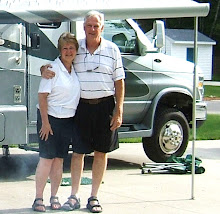



 The upper loop is our route today. Beautiful scenery surrounds us we meander through the Hayden Valley. This rolling valley is an old lake bed formed when glaciers created a lake during the last Ice Age. Today it’s known for it’s wildlife. We saw about 150 Bison roaming the meadow this morning.
The upper loop is our route today. Beautiful scenery surrounds us we meander through the Hayden Valley. This rolling valley is an old lake bed formed when glaciers created a lake during the last Ice Age. Today it’s known for it’s wildlife. We saw about 150 Bison roaming the meadow this morning. Rolling through meadows and groves of Lodge Pole Pines we took the Virginia Cascade scenic drive. It was cool along the river and very relaxing. The cascade tumbles 60 feet down a fairly gradual slope into a deep canyon. The falls are very close to the narrow roadway so there are very few places to pull off to see the falls.
The Museum of the National Park Ranger was our first stop. The museum is located in one of the original soldier station buildings built in 1908. It was an outlying building for soldiers on patrol. Today the station stays true to the original floor plan and uses original material. We saw the exhibits showing the development of the park ranger profession from it’s roots in the military to the early rangers to the current National Park Service staff. We watched a short film “An American Legacy” telling the story of the museum. This is a fantastic place. We should be glad Teddy Roosevelt was such a conservationist.
Off to Mammoth Springs. Along the Upper Loop Road we see mountains 10,000 feet high that stand tall over the floor of the forest which is a lush green. This is bear country but we haven ‘t seen any yet. As we get closer to Mammoth Springs the landscape turns to volcanic again. We stopped at Bunsen Peak which looks like a mosaic with the trees burnt from fire and the natural regrowth starting to reassert itself.
Mammoth was awesome and very different from the other geyser pools. This is one of the parks most dynamic hydrothermal areas; its constantly changing. The maximum water temperature here is 165 degrees. Limestone was deposited here millions of years ago when a huge sea covered the area. The hot water dissolves the limestone and creates a carbonic acid. At the surface, the calcium carbonate is deposited in the form of travertine, the rock that forms the terraces of Mammoth Hot Springs. These terraces are like living sculptures, shaped by the volume of water and the slope of the ground. They change constantly, sometimes overnight!
Stopping at the main overlook on the Upper Terrace Drive and walked the boardwalk trail down to the Canary Spring. This is a new formation. It is prominently yellow in color near the vent and you can listened to the cascading water running between the formations. We continued on the one way route around the Upper Terrace coming to the New Highland Terrace where tree skeletons stand as testaments to a landscape created in the 1950’s. Each stop was more breathtaking than the last!
Finishing the Upper Terrace Drive we headed toward the lower terrace and the Mammoth Springs Hotel. We drove past the spectacular Jupiter and Mound Terraces. These show cycles of activity typical of the area. After being inactive for decades Mound Terrace began to show new patterns where chunks of the soft rock had fallen off. In the 1980’s, Jupiter flowed heavily and overtook boardwalks several times. If you didn’t know better you would think this was a huge mound of snow!
Leaving Mammoth we drive across the Black Deer Plateau to Tower Roosevelt changing back to lush meadows flowing into groves of Loge Pole Pines. We stopped at Lava Creek for lunch. There were tables right along the creek and we enjoyed the sound of the water and relaxed . After lunch we took the Black Deer Drive winding along the top of the plateau. Taking a break we parked in a pull off called Northern Range. There was a boardwalk trail and we decided to go exploring. There was no one else on the trail. Having the area all to ourselves we sat and listened to the wind and birds. The interpretive signs taught us about the flowers and hills surrounding us . It was so peaceful.
It’s mid afternoon now and we have moved into Roosevelt Country. This section is known for its rolling hills covered with sagebrush, fir, pine, spruce, and aspen. This is accented by the sparkling stream which are loaded with trout. No time to fish, we decided to continue on into the Lamar Valley. This is known as the Serengeti of Yellowstone. This place is unbelievable. It’s about 4PM so we didn’t see a lot of wildlife. As we headed through the valley we found ourselves high in the mountains of Ice Box Canyon near the Northeast Entrance of the park. There is no way to describe to anyone the magnificent natural beauty we are seeing. It started to cloud up and get very dark. We are up about 10,000 feet and we didn’t want to get caught in a storm so we turned around just south of the entrance and headed back. On our way back we had some snow flurries.
Driving south toward Canyon Village we found ourselves climbing out of the valley and over the Dunraven Pass which takes us over Mt Washburn (10,234 ft). Very high but fantastic! The park is so big and every place you go is more spectacular than the one before.
Today has been terrific.
Picture Notes: Virginia Cascade, Norris Soldier Station, Bunsen Peak, Mammoth Springs from Upper Terrace, New Blue Spring (Mammoth)

No comments:
Post a Comment